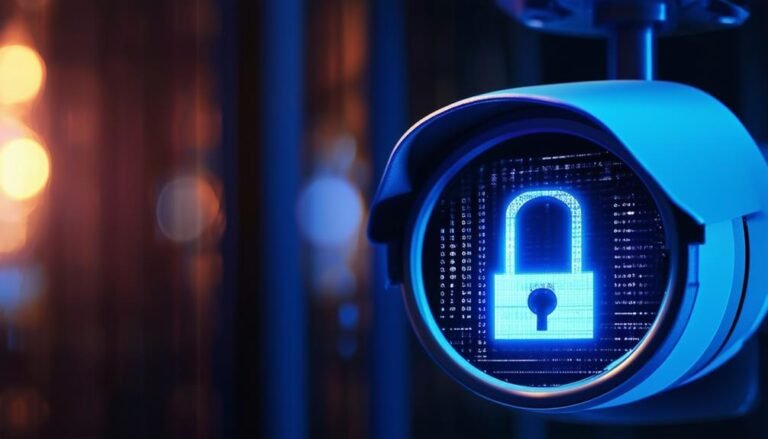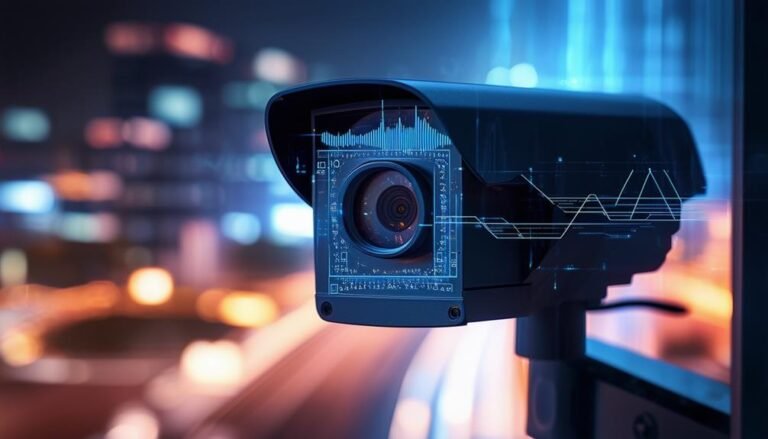To reset your Dahua IP camera, first identify your camera model, as steps may vary. For a soft reset, unplug the camera for about 30 seconds, then plug it back in. If you're facing persistent issues, try a hard reset: locate the reset button, power cycle the camera, and press the reset button for 10-15 seconds until the LED blinks. After the reset, all settings will revert to factory defaults, so you'll need to reconfigure your network and camera settings. If you're curious about additional troubleshooting or setup tips, there's more to explore.
Understanding Your Dahua IP Camera
Understanding your Dahua IP camera is essential for effective usage and troubleshooting. When you grasp how your camera operates, you can enhance your security setup and guarantee your peace of mind. These cameras are designed to provide flexibility and control, allowing you to monitor your space from anywhere. You'll want to familiarize yourself with its features, such as motion detection, night vision, and remote access.
First, take a look at the camera's specifications. Knowing the resolution, field of view, and connectivity options can help you optimize its placement and performance. A well-placed camera can make all the difference in capturing clear footage.
Next, explore the software that accompanies your Dahua camera. The user interface is designed to be intuitive, but understanding how to navigate it will empower you to customize settings according to your needs. Whether it's adjusting the sensitivity of motion detection or scheduling recordings, having control means you can tailor your security measures to fit your lifestyle.
Lastly, don't overlook the importance of regular updates. Keeping your camera's firmware up-to-date guarantees you have the latest features and security patches. This simple step can prevent potential vulnerabilities and allow you to enjoy the freedom of a secure environment.
Preparing for the Reset
Before you start the reset process, it's essential to identify your specific Dahua camera model, as the steps can vary. Make sure you gather all necessary tools, like a reset pin or screwdriver, to avoid any interruptions. Being prepared will make the reset smoother and more efficient.
Identify Camera Model
Identifying your Dahua IP camera model is essential for a successful reset, as different models may have varying reset procedures. You can usually find the model number on the camera itself, either on the back or on a label attached to the device. If the camera's exterior isn't clear, you can also access the camera's web interface. This will often display the model number in the system information section.
If you're not sure where to look, check the user manual that came with your camera—this often includes the model number and specific details about your device. Alternatively, you can visit the Dahua website and search for your camera using the serial number, which is another way to identify the model.
Once you know your camera model, you'll be equipped to follow the correct reset procedure. This awareness not only saves you time but also guarantees you're taking the right steps to regain control over your device. Remember, each model has its quirks, so knowing this detail is your ticket to freedom from any frustrating issues. Embrace the process, and you'll have your camera back on track in no time!
Gather Necessary Tools
Having the right tools on hand can make your Dahua IP camera reset process much smoother. You'll want to gather a few essentials before diving into the reset procedure. First, get a small, pointed object like a paperclip or a pin — this will be essential for pressing the reset button.
Next, have your camera's power adapter ready, as you'll need to power it on during the reset. If your camera is mounted in a hard-to-reach place, consider having a step ladder or stool to guarantee you can easily access it. A laptop or smartphone with internet access can also be handy for checking any specific instructions related to your camera model.
Lastly, make certain you have a notepad or digital device nearby to jot down any important settings or configurations you might want to reapply post-reset. Being prepared not only saves time but also gives you the freedom to reset your camera without unnecessary interruptions. So, gather these tools, and let's get ready to reclaim control over your Dahua IP camera setup!
Soft Reset Method
Occasionally, you might need to perform a soft reset on your Dahua IP camera to resolve minor issues without losing your settings. This method is simple and can often fix problems like connectivity issues or camera glitches. A soft reset allows your camera to refresh its settings without wiping any of your custom configurations. Here's how to do it.
- Power Off: Unplug the camera from the power source.
- Wait: Keep the camera unplugged for about 30 seconds.
- Power On: Plug the camera back into the power source.
Once it powers up, your camera should be functioning normally. If it's still not working correctly, you might need to check your network settings or consult the user manual for more in-depth troubleshooting tips.
Here's a table summarizing the soft reset steps:
| Step | Action | Purpose |
|---|---|---|
| 1 | Power Off | Disconnect power |
| 2 | Wait 30 seconds | Allow system to reset |
| 3 | Power On | Restore normal operation |
| 4 | Check connections | verify proper setup |
| 5 | Monitor performance | Confirm issue resolution |
Hard Reset Method
If you're looking to perform a hard reset on your Dahua IP camera, the first step is to locate the reset button. Once you've found it, you'll need to power cycle the camera to restore default settings. This method can help resolve any persistent issues you're facing.
Locate Reset Button
To successfully reset your Dahua IP camera, you'll first need to locate the reset button, which is vital for performing a hard reset. This button is typically a small, recessed switch found on the back or bottom of the camera. It's often labeled as "RESET" to make it easier for you to identify.
To find it, you may need to gently tilt or flip the camera, depending on its model. Grab a flashlight if you need extra light to see clearly inside any tight spaces. Once you've located the reset button, you'll want to prepare for the next steps. Keep in mind that the button might be small, so it's best to use a pointed object like a paperclip or a pin to press it.
You'll need to press and hold this button for about 10-15 seconds. This action will initiate the reset process, restoring your camera to its original factory settings. Remember, finding this button is a significant step in regaining control and ensuring your camera functions as intended. So take a moment to locate it and get ready for the reset!
Power Cycle Camera
After locating the reset button, the next step is to power cycle your camera as part of the hard reset method. This process is simple and can help clear any temporary glitches that might be hindering your camera's performance. To power cycle, first, unplug the camera from its power source. It's essential to verify that the camera is completely disconnected, so give it a few seconds—around 10 to 30 seconds is ideal.
Once you've waited, plug the camera back in. You should notice the camera's lights flicker as it starts up again. This action effectively clears the temporary settings and can provide a fresh start, allowing you to regain control over your device.
Default Settings Restoration
When you're ready to restore your Dahua IP camera to its default settings, performing a hard reset is the most effective method. This approach wipes all custom configurations, giving you a fresh start. You'll need to locate the reset button on your camera, usually found on the back or bottom.
First, make sure your camera is powered on. Using a pointed object, press and hold the reset button for about 10-15 seconds. You'll notice the camera's LED lights will blink, indicating it's resetting. Once the lights stabilize, you can release the button. At this point, your camera should be reset to factory settings, freeing you from any previous configurations that may have caused issues.
After the reset, you'll need to reconfigure your camera settings, such as network connections and security features. Keep in mind that all previous settings, including passwords and user profiles, will be erased, so make sure you're ready to set it up anew. This hard reset method is your ticket back to a clean slate, allowing you to regain control and customize your Dahua IP camera according to your preferences.
Reconfiguring Your Camera
Reconfiguring your Dahua IP camera is a straightforward process that assures you can tailor its settings to meet your specific needs. Once you've reset the camera, you'll want to connect it to your network. Start by accessing the camera's web interface through a browser on your computer. Enter the camera's IP address, and log in using the default username and password—usually "admin" for both.
From here, you can modify settings like resolution, frame rate, and bitrate to optimize your camera's performance. If you're planning on using remote access, enable the P2P feature or set up DDNS for easier access without needing to remember IP addresses.
Next, adjust the motion detection settings. You can set specific zones for detection and customize sensitivity levels. This helps avoid false alarms and guarantees you're only notified when something important happens. Don't forget to tweak the recording settings based on your preferences, whether you want continuous recording, scheduled recording, or event-based recording triggered by motion detection.
After making these adjustments, always remember to save your changes. It's also wise to create a backup of your configuration settings periodically. This way, if you ever need to reset the camera again, you can quickly restore your tailored settings. By taking these steps, you'll have a Dahua IP camera that works perfectly for your unique surveillance needs, giving you the freedom and control you desire.
Troubleshooting Post-Reset Issues
Troubleshooting post-reset issues can feel intimidating, but it's often manageable with a systematic approach. After resetting your Dahua IP camera, you might encounter problems like connectivity issues, failure to login, or blurry images. Don't worry; these are common and can usually be resolved swiftly.
First, check your network connection. Verify the camera is properly connected to your router, either via Ethernet or Wi-Fi. If you're using Wi-Fi, double-check that you've entered the correct SSID and password during the reconfiguration. Sometimes, simply rebooting your router can help establish a better connection.
Next, if you can't log in, make sure you're using the default credentials. Many Dahua cameras reset to a default username of "admin" and a blank password. If you've set a new password before the reset, you'll need to remember that or reset again.
If the camera image appears blurry, adjust the focus manually. Most Dahua cameras have a physical lens that can be rotated for clarity. If the issue persists, check for any obstructions in the lens or clean it gently with a soft cloth.
Lastly, if problems continue after these steps, consider updating the firmware. Outdated firmware can lead to performance issues. Visit Dahua's official website to download the latest version and follow their installation instructions.
Frequently Asked Questions
Can I Reset My Dahua IP Camera Remotely?
Isn't it interesting how technology sometimes feels like it holds us captive? When it comes to resetting your Dahua IP camera remotely, it's not typically possible without direct access. Most devices require a physical reset for security reasons. However, if you've set up remote management options, you might find some settings that allow adjustments. Just remember, maintaining your freedom with tech means staying informed about these limitations.
Will Resetting Erase All My Camera Settings?
Yes, resetting your camera will erase all your settings. You'll lose your configurations, including Wi-Fi details and any custom adjustments you've made. Think of it as starting from scratch, which can be liberating if you've had issues but also a hassle if you had everything set up just right. Make sure to back up any important information before you proceed, so you can easily restore your preferred settings afterward.
How Often Should I Reset My IP Camera?
You should consider resetting your IP camera whenever you notice connectivity issues, performance drops, or after a firmware update. It isn't necessary to reset it frequently; doing so too often can be disruptive. Instead, monitor its performance, and if things seem off, it's a good time for a reset. Trust your instincts—if you feel it's acting up, don't hesitate to give it a fresh start and restore its efficiency.
Can I Reset Without Physical Access to the Camera?
Resetting an IP camera without physical access feels almost like trying to hug a cloud—it's just not gonna happen! Unfortunately, you can't reset it remotely unless you've set up specific software or access permissions beforehand. If you value freedom in managing your devices, make sure to establish remote control options when you first set it up. Otherwise, you'll need to get up close and personal with the camera to reset it.
What if the Reset Button Is Unresponsive?
If the reset button's unresponsive, don't worry just yet. First, double-check if you're pressing it correctly or long enough. Sometimes it takes a firm press or a longer hold to trigger a reset. If that doesn't work, consider unplugging the camera for a minute and plugging it back in. If all else fails, you might need to reach out to the manufacturer for further assistance or a potential hardware issue.



